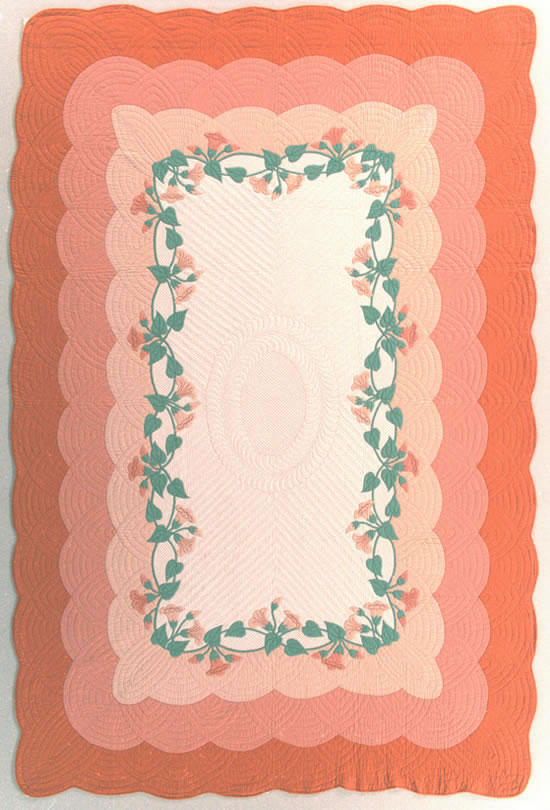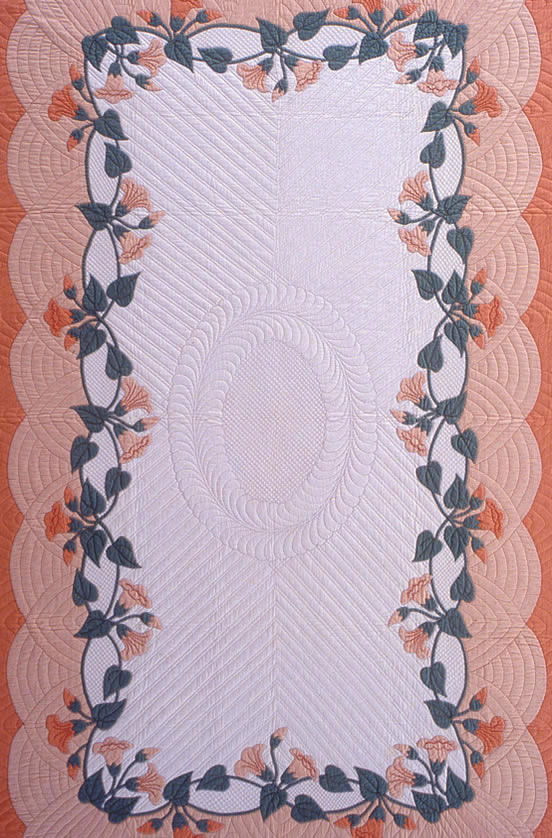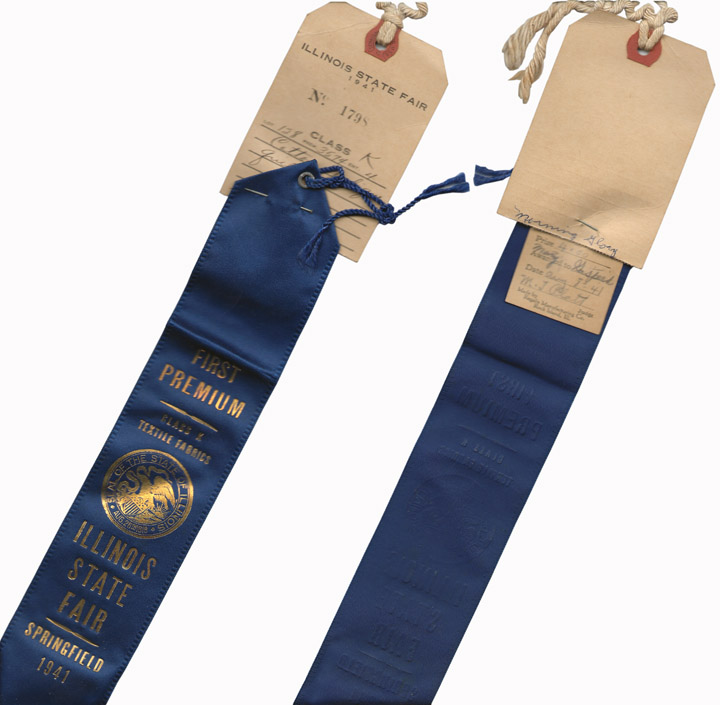
QUILT INDEX RECORD
18-14-32
Description:
This is one of two Apricot Morning Glory quilts made by Gasperik. The quilting on the two quilts is slightly different and there are fewer green leaves appliquéd into the wreath on this quilt. These details are discernible in a photograph album sent to Germany in 1947. The morning glory quilt pictured in that album is clearly this quilt (and not its twin, #062). That album page, which also includes a photo of Hungarian Harvest Festival Quilt (#014), is inscribed "Mary Gasperik's First two prize winning quilts." The aforementioned prize was a blue ribbon at an Illinois State Fair in 1941.
Essay:
The quickest way to distinguish the two Apricot Morning Glory quilts is to look at the leaves appliqued at the very top and bottom of the appliqued wreath. They are a duo on this quilt and a trio on quilt #062.
Where are the records for this quilt housed?
Mary Gasperik Legacy Project
Who documented this quilt?
Mary Gasperik Private Collection
Gasperik Legacy Project Number:
026
This is a:
Finished quilt
Quilt's title:
Morning Glory
Owner's name for quilt:
Apricot Morning Glory (Linda)
Names for quilt's pattern in common use:
Morning Glory Wreath
How wide is the quilt?
68 inches
How long is the quilt?
103 inches
Shape of edge:
Scalloped
Shape of corners:
Scalloped
What color is the quilt?
Green; Orange; White
Overall color scheme:
Light or pastel colors
Quilt's condition:
Excellent/like new
Describe the type of inscription:
cloth exhibit label sewn to back
What is inscribed on the quilt?
MARY GASPERIK 9314 Cottage Grove Ave. Chicago, Ill.
Location of inscription:
on back
Time period:
1930-1949
When was the quilt finished?
1938-1945
Date estimated by an antique dealer, quilt historian or appraiser:
1938-1945
Who estimated the quilt's date?
Merikay Waldvogel
Further information concerning dates:
Earliest estimated date is based on a 1938 packing slip for Bucilla kit #2005, Morning Glory.
Describe the quilt's layout:
Medallion or framed center
Number of borders:
3
Describe the borders:
Three wide borders echo the scalloped edge. Colors of border are shaded from dark apricot, through medium apricot to light apricot. Center panel is encircled with a morning glory vine. This border design element is part of the Bucilla kit #2005, Morning Glory.
Fiber types used to make the quilt top:
Cotton
Fabric styles used in the quilt top:
Solid/plain
Applique techniques used to make the quilt top:
Hand Applique
Embellishment techniques used to make the quilt top:
Embroidery
Materials used to make the back:
Cotton
What color is the back of the quilt?
White
Describe the back:
Solid/plain
Materials used in the quilt binding:
Cotton
How is the binding made?
Bias grain
What is the width of the binding (measure on the top only)?
less than a half inch
What kind of filling is used in the quilt?
Cotton
How are the layers held together?
Hand quilting
Color of thread used in the quilting:
white
Can you see any knots on the front or back of the quilt?
no
Quilting designs used, overall motifs:
Double parallel lines; Echo
Quilting designs used, decorative motifs:
Wreaths
Quilting designs used, background fills:
Grid/crosshatch; Parallel lines
Features or notes about the quilt's appearance, materials, or construction:
It is thought that this quilt was completed years before its similar-looking mate (#062). The major difference between the two quilts, other than the fact that #026 has fewer green leaves, lies in the quilting design. Both quilts have a double wreath filled with cross-hatching as their centerpiece; but the space between that quilted wreath and the applique wreath is handled differently on the two quilts. On quilt #026 double parallel lines of quilting meet in a flat chevron. On quilt #062 (thought to have been completed later) the dense lines of quilting criss-cross, creating the effect of three dimensional space. This experimentation is reminiscent of Gasperik's series of Indiana Wreath quilts (see #011, #032, #043 and #063). The quilting inside those wreaths also plays with different ways of creating a sense of three-dimensional space through quiltING alone.
Quilt top made by:
Gasperik, Mary
Quilted by:
Gasperik, Mary
Where the quilt was made, city:
Chicago
Where the quilt was made, county:
Cook County
Where the quilt was made, state:
Illinois (IL)
Where the quilt was made, country:
United States
How was this quilt acquired?
Inheritance
Tell the story of how the quilt was obtained:
Selected by Elsie during a division of quilts (with her sister-in-law) after Gasperik died. When Elsie Krueger died in 1988 and her three daughters divided their mother's share of Gasperik quilts, this was Linda's pick.
Why was the quilt made?
Personal enjoyment
The quilt was made to be used for:
Bedding, special occasion
Quilt is presently used as:
Keepsake/memento
Describe present uses of the quilt:
Mary's grandchildren regard her quilts as a unique collection to be preserved and appreciated.
Where did the maker get their materials?
Purchased new
Where did the maker find their pattern?
Commercial/Published source: Book; Commercial/Published source: Newspaper; Commercial/Published source: Kit
Commercial name of the pattern for the top:
Probably Bucilla kit #2005, Morning Glory.
Where did the quiltmaker find the pattern for the quilting design on the quilt?
Kit
What is the commercial name of the quilting design used for this quilt?
Quilted oval feathered wreath may be adapted from quilting design #521 in Colonial Quilts, by Hubert Ver Mehren.
Describe anything about the design of the quilt that wasn't already recorded in a previous field:
Bucilla Applique Bedspread Morning Glory Design No. 2005 kit at first glance appears too have been Gasperik's pattern source; but upon close examination Bucilla's flower appliqué pattern units and their arrangement on the overall quilt do not match the Gasperik Morning Glory quilts. The Bucilla kit #2005, Morning Glory. includes multicolored flowers, and their flower and leaf pattern shapes do not match the shapes on the Gasperik quilts. The soft tones of the two Gasperik Apricot Morning Glory quilts (#026 and #062) are quite different from the harsher oranges of the kit’s fabrics. Of the four Gasperik Morning Glory quilts (two in shades of apricot and two in shades of blue) three of them have symmetric arrangements of a trio of flowers and leaves centered in each of the four sides of the squared off wreath. One quilt, however, this one in particular, has an asymmetrical arrentment in each of these four locations. Instead of three leaves, there are only two in these four positions. Oddly, this same asymmetrical arrangement is found on a non-Gasperik quilt Susan Salser purchased on eBay, and also on a pair of Morning Glory Wreath quilts (probably made in the same period of time, the mid 1940s, in Minnesota) appraised by Karen Dever in 2020. There is clearly a shared commercial pattern source for these four quilts, although it cannot be said at this time exactly what that source was, only that is was NOT the Bucilla kit #2005, Morning Glory. It is likely that this Gasperik Morning Glory Wreath quilt is first of the series of four which Gasperik made, because it so faithfully follows the design patterns specified by the as-yet unidentified commercial pattern source. The blue pair of Gasperik Morning Glory Wreath quilts diverges the most, especially in its quiltING design, from the unknown pattern or kit source which was the likely source of this particular quilt's design.
Exhibitions where this quilt was displayed:
An exhibit tag which is separated from its quilt reads "Morning Glory Wreath First Prize in, Springfield Mrs. Mary Gasperik". This corresponds to a First Prize ribbon from the Illinois State Fair, 1941.
This is one of the 23 Mary Gasperik quilts exhibited in the Carnegie Room of the Marion Indiana Public Library July 16-17, 2021 in connection with the ceremony honoring the induction of Mary Gasperik into The Quilters Hall of Fame as their 2021 Legacy Quilter honoree. Mary Gasperik Quilters Hall of Fame Induction Exhibit.
Contests entered:
Illinois State Fair, 1941, First Place ribbon
The caption in the 1947 photo album under a picture of this quilt indicates that it won a prize but doesn't specify where or when.
Publications (including web sites) where this quilt or maker was featured:
Merikay Waldvogel and Barbara Brackman. Patchwork Souvenirs of the 1933 Chicago World's Fair, (Nashville, TN: Rutledge Hill Press, 1993)102-103.
Merikay Waldvogel "One American Dream Comes True", Quilters Newsletter Magazine, March 2008, 46-49.
Related items such as diaries, obituaries, wills, household inventories, or pictures of the quiltmaker:
Complete Bucilla kit #2005 Morning Glory (Susan Salser - private collection); Nancy Cabot newspaper illustration of Morning Glory; Marie Webster's color photo of child's quilt Morning Glory.
There was probably at least one other 1930s kit for making a Morning Glory Wreath quilt similar to the four made by Mary Gasperik. In 2006 Salser bought on ebay a similar-looking Morning Glory Wreath quilt executed in three shades of apricot. In its flower patterns and colors this quilt more resembles the two Gasperik apricot Morning Glory quilts than it does Bucilla kit #2005, Morning Glory. The seller was the niece of the maker, who was named Charlotte Louise Greene (1897-1993). When asked for information about the quilt-maker, the niece wrote: "I really don't know a lot about my Aunt's quilt making. She had a lot of interests - was very smart. (She studied ballet with Martha Graham and corresponded all her life with Norman Vincent Peale.) Kind of went from one interest to another. She was fired up about quilt making for a while and then dropped it for something else. She wasn't particularly artistic that I recall, so I suppose she didn't design her own quilts but probably may have bought designs from another source" (e-mail to Susan Salser from Anne Botto, 2/24/2006).
Photo album sent by Stephen and Mary Gasperik to the family of their future daughter-in-law in Germany, 1947 includes photos of quilt #026 and #014, captioned "Mary Gasperik's first two prize-winning quilts".
Ownership of this quilt is:
Private
Quilt owner's name:
Linda Krueger MacLachlan
Quilt owner's country:
United States
Person filling out this form is:
Relative of quiltmaker; Author/researcher
If you are a relative of the quiltmaker, how are you related? The quiltmaker is my:
Grandmother
Describe the relationship to the quilt's maker:
Grand-daughter Susan Salser began this research effort in 1991, after she and her two sisters divided up the quilts which belonged to their mother (Elsie Gasperik Krueger) who died in 1988. Her ongoing research has been fruitful and interesting.
Quiltmaker's maiden name:
Mihalovits, Maria
Quiltmaker's gender:
Female
Quiltmaker's birth date:
01/25/1888
Quiltmaker's birthplace, country:
Hungary
Quiltmaker's marriage date(s):
11/18/1906
Quiltmaker's date of death:
05/25/1969
Quiltmaker's ethnic background/tribal affiliation:
Hungarian
Quiltmaker's educational background:
Elementary School
In which kind of environment did the quiltmaker live?
Rural
Quiltmaker's city:
Chicago
Quiltmaker's county:
Cook
Quiltmaker's state:
Illinois (IL)
Quiltmaker's country:
United States
Quiltmaker's father's name:
Mihalovits, Istvan
Quiltmaker's father's birthplace:
Hungary
Quiltmaker's father's ethnic/tribal background:
Hungarian
Quiltmaker's mother's name:
Mihalovits, Vidoszava
Quiltmaker's mother's birthplace:
Hungary
Quiltmaker's mother's ethnic/tribal background:
Hungarian
Quiltmaker's spouse's/spouses' and /or partner's/partners' name(s):
Gasperik, Stephen
Quiltmaker's spouse's/spouses' and/or partner's/partners' ethnic/tribal background:
Hungarian
Quiltmaker's spouse's/spouses' and/or partner's/partners' occupation:
Milk Dealer/Grocery Store Owner/Butcher
Number of children:
3
How many of the quiltmaker's children were girls?
1 (Elsie 1909-1988)
How many of the quiltmaker's children were boys?
2 (Elmer and Stephen)
How did the quiltmaker learn to quilt?
From guild or club member; Self-Taught
When did the quiltmaker learn to quilt?
Age 40-49
Why does the quiltmaker quilt?
Pleasure; Other
Other notes on how the quiltmaker learned, and how and why they quilt:
To exhibit in shows held by her Tuley Park quilt club in Chicago, the Detroit News quilt show in Detroit, many Illinois State Fairs, at least one Indiana State Fair. She entered quilts in at least 2 Chicago department store contests. She made at least one quilt and one quilt top specifically for the 1939 New York Worlds Fair quilt contest. She also made children's quilts specifically for grandchildren and great-grandchildren; and wedding and wedding anniversary quilts for her son Elmer and grand-daughter Karen. Primarily, she wanted to make quilts because it was her life passion and her greatest talent. The occasions and venues to show them presented themselves. It should be noted that prior to Mary's emigration to America in late 1904, at age 16, she was an apprenticed needleworker in her native Hungary. The intricate and colorful floral embroideries traditional to Hungary lend themselves especially well to applique, the quilt style Mary preferred.
Does/did the quiltmaker belong to a group? Name of the group?
Tuley Park Quilt Club and Detroit News Quilt Club
Does/did the quiltmaker belong to a group?
Southside Chicago and Detroit MI
What are the main activities of the group?
Chicago group met to quilt and held periodic quilt shows; Detroit group held national exhibits and contests.
Estimated number of quilts made by this quiltmaker:
more than 50
Does/did the quiltmaker sell quilts?
no
Does/did the quiltmaker teach quilting?
no
Who photographed this quilt?
Don Gonzalez
Access and copyright information:
Restricted
Copyright holder:
Hank Finn
Details
Cite this Quilt
Gasperik, Mar. Morning Glory. 1938-1945. From Mary Gasperik Legacy Project, Mary Gasperik Private Collection. Published in The Quilt Index, https://quiltindex.org/view/?type=fullrec&kid=18-14-32. Accessed: 04/26/24
-
Gallery
Gasperik 04: Kit Quilts
Waldvogel, Merikay
-
Ephemera
Morning Glory Design No. 2005
Bucilla
-
Exhibit
Mary Gasperik Quilters Hall of Fame In...
Salser, Susan
-
Gasperik, Mary Quiltmaker
Mary Gasperik Legacy Project
-
1935-1945
Morning Glory Gasperik, Mary
-
1938-1945
Morning Glory Gasperik, Mary
-
1938-1945
Morning Glory Gasperik, Mary

